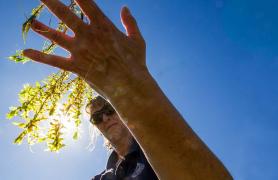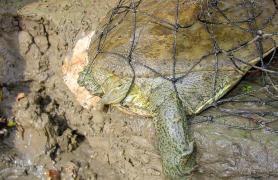Many families, upon moving into a new home, personalize the property with some new landscaping. Janelle and Brad Sjue went beyond the typical shrubs and border annuals when they moved into their home in the Kansas City-area community of Brookline.
“When we bought our house, it was all asphalt,” Janelle Sjue said. “We had the asphalt ripped out, and then we were like, ‘Okay, we’re at ground zero,’ so we brought in dirt and decided to go with natives for planting to feed animals, initially.”
The native plantings for feeding nature soon evolved into raised garden beds and fruit trees for feeding themselves. And it continued.
“Then we decided there’s a whole circle of life thing going on here,” she said. “We got chickens to keep the bugs down instead of having to do pesticides. Of course, we benefitted from the eggs, and the kids had a lot of fun raising the chicks.”
Soon the Sjues and their four children, ages 7 to 16, were fully immersed in the culinary and social phenomenon known as the locavore movement.
What’s Old is New Again
Commonly defined as people who mainly eat locally produced food, locavores range from those who shop extensively at local farmers markets to those who grow, forage, or harvest the majority of their own food. Motivation for those who adopt such a dietary lifestyle ranges as well, from supporting the local economy to seeking a better connection to the food they eat, said James Worley, an education specialist with MDC’s Anita B. Gorman Conservation Discovery Center in Kansas City.
“People are concerned about where their food comes from,” Worley said. “They’re very concerned about it being raised humanely, harvested humanely. They want it to be locally sourced. They want it to be free-range, non-GMO, organic. Wild fish and game fits the bill, fits all the definitions of what foodies are interested in when it comes to protein.”
For the Sjues, the journey to the locavore lifestyle has been incremental, which intensified after they had children.
“It really was baby steps,” said Janelle Sjue. “After we had kids we decided, ‘Why are we putting chemicals on our yard and then letting our kids go out and play in it.’ And then we were like, ‘How wise is it to have a yard?’ And that’s how we moved. What is the grass giving back to us, except keeping us out there mowing and raking? So that’s kind of where we started, the idea of waste and — even our tiny little yard — using it wisely.” The process has been an educational one, with the family frequently taking advantage of the courses and resources offered at the Discovery Center, she said.
“We’re learning as we go,” she said. “We’re urban people, so a lot of times we’re scratching our heads over the solution to whatever the problem is.”
While the term “locavore” and the movement that bears its name is decidedly 21st Century, the idea of eating that which comes from local producers, from one’s own backyard, or from one’s last hunting or fishing trip has a much longer history, especially in Missouri’s rural communities.
Tom Modine, who lives in Kearney, north of Kansas City, was locavore before the term existed. “We’ve always had huge gardens. That’s the way we grew up,” Modine said. “We grew all of our own vegetables or a large proportion of them. I grew up eating a lot of wild game meat.”
It’s a lifestyle Modine and his wife, Becky, have passed down to their three daughters, ages 11–21. “They’ve grown up this way,” he said. “They’ve been butchering deer and ducks since they’ve been able to walk. It’s no big deal. And they’ve been cleaning fish and catching fish all that time, also.”
From Field to Fork
On an evening last August, Brad Sjue and Tom Modine were two of nearly 40 guests at one in a series of what have become some of MDC’s most popular dinner parties. Called the Field to Fork series, the event draws heavily from the locavore community, Worley said.
“Our attendance here — this is about our third year of doing it — is about 50 percent foodies, people who are just wanting to try new game and fish and understand where wild game and fish come from and how it’s turned into dishes,” he said. “It’s about 25 percent young couples who are starting families, and they’re wanting to hunt and fish and provide fish and game for their families. And then it’s about 25 percent old timers who have been here and done that, and they’re looking for new ways to turn their fish and game into something beyond deer chili, fried fish, and jerky and sausage.”
The event also draws some of Kansas City’s most accomplished and innovative chefs to prepare wild game and fish. The goal is to introduce participants to the variety of ways to prepare these natural dishes, and move beyond the standard fare, said Worley.
“I love fried fish, and I love deer chili — who doesn’t? — but people want more now. Their palates are more adventurous, and they want to try new things,” he said. “They want it to be beautiful, and they want it to be delicious and incorporate local ingredients and unique ingredients and have different flavors and textures.”
Which is why, Worley explained, he reached out to the city’s culinary community. But what brings some of the city’s most respected chefs out of their kitchens to prepare whatever Worley shoots, hooks, or snags? Opportunity and challenge, he said.
“They get to do something they don’t get to do in their restaurants. They get to cook fish you can’t sell, you can’t cook because of regulations, and they’re around people who are really appreciative,” Worley said. “There’s nobody here who’s not wanting what’s happening in this room. You get people in the restaurant who are not happy, but they don’t have anybody who’s not happy in here.”
Past programs have included familiar game, including venison, squirrel, and panfish, but this night’s menu challenged the guest chefs with buffalo fish, gar, and catfish. Chef Jasper Mirabile Jr., of Jasper’s Italian Restaurant, says these aquatic afterthoughts offer more than meets the eye.
“You’ve got this big ugly fish — and it’s an ugly fish — and 15 minutes later it’s as flaky as can be and just melts in your mouth,” he said. “I eat it right off the grill.”
In many cases, overcoming people’s perceptions is a bigger obstacle than turning the catch of the day into a culinary delight, he said.
“You hear people talk about catfish, ‘Ooo, I’m not going to eat it.’ The name itself, I guess,” he said. “If I didn’t tell anybody that it’s catfish, people would think, ‘It’s so flaky. It’s so flavorful. What is this? What Mediterranean fish is this?’ What Mediterranean fish? Come on, it’s catfish. Missouri catfish.”
Similarly, Chef Mickey Priolo and Chef Rick Mullins find opportunity and challenge in Worley’s offerings, especially on this evening.
“This is part of why we love doing this with James Worley because he’s always giving us these things we’ve never cooked with,” said Mullins, who is the chef de cuisine at Gram & Dun in Kansas City. “I’ve never cooked with buffalo fish. This
is not what you order from your fish purveyor at your restaurant.”
Field to Fork not only offers the pair a challenge, it also offers them the opportunity to share their own passion for locally sourced food. Mullins and Priolo, who is the general manager of Café Sebastienne in Kansas City, are the founders of Soil Collective, a cadre of area chefs applying culinary solutions to social issues. Under the Soil Collective banner, and working with other like-minded chefs, the two host dinners throughout the Kansas City area featuring only locally sourced foods, including wild ingredients they find.
“We forage for berries, mushrooms wild herbs, wild onions, wild garlic, things like that,” Mullins said.
The two see food, especially locally sourced food, as an avenue for addressing other concerns, including connecting local food producers with local restaurants, eliminating food waste, and combating hunger and unemployment. “It’s about us learning, growing, being good people,” Priolo said. “And then trying to educate as well and trying to get people on board with the idea of let’s treat everything better: the environment,
ourselves, people around us.”
Getting Started
While the Field to Fork events focus primarily on preparing fish and game, or the “fork” element of the program title, Worley uses the opportunity to encourage participants to explore the “field” as well — as active anglers and hunters.
“In the program, I talk about game populations,” he said. “I talk about how fishing and hunting are methods we use to keep the populations at acceptable levels. Those levels are identified through research-based science, which is used to set seasons and limits.
“We get into methods of harvesting and locations, places to go around the metro area. Then we dive in.” Building on what they had learned in Field to Fork and the other consumptive classes taught by Worley, the Sjues have begun fishing and are preparing themselves to take the next step toward harvesting wild game of their own, Janelle Sjue said.
“We’re trying to move to the next step. James is really working on getting people who are unfamiliar with harvesting animals,” she said. “Growing plants feels more comfortable than harvesting animals, so we’re starting to look at going to the next phase of hunting and fishing.”
That next step for the Sjues has included attending MDC’s hunter safety course, family fishing outings, and mentored fishing trips with Worley, Brad Sjue said. “It’s been a really great educational experience,” he said. “My son and I went
out with James on a fishing trip earlier this summer. We caught catfish, then learned how to skin and cook them. It was really great.”
That transition, from local consumers or home gardeners to active harvesters of fish and wildlife, can be intimidating, especially for those without a family tradition of hunting and fishing, Worley said, but MDC is there to help.
“As a department, we have lots of clinics, classes, and opportunities to learn,” he said. “We have fishing clinics, hunting clinics, and mentored hunts, things like that.”
Food for the Soul
While there was unanimous agreement among the Field to Fork participants that wild fish and game, prepared by the right hands, is delicious and healthy, the upside of getting outdoors to hunt and fish goes beyond nutrition. Brad Sjue sees his family’s move to the locavore lifestyle, including hunting and fishing, as providing additional social and developmental benefits, especially for their children.
“What I really hope they get out of all of this is the desire to engage in their local communities, their local conservation areas, go spend time outside: fishing, hunting, exploring, hiking, being independent,” he said. “It gives them this sense of independence, playing in nature that most of us had growing up, but a lot of kids in the city don’t.
Want to start fishing or hunting?
MDC’s programs can help. Visit short.mdc.mo.gov/ZTW for information on
getting started fishing and short.mdc.mo.gov/Z4q for help with hunting.
































Also In This Issue


And More...
This Issue's Staff
Associate Editor - Bonnie Chasteen
Staff Writer - Larry Archer
Staff Writer - Heather Feeler
Staff Writer - Kristie Hilgedick
Staff Writer - Joe Jerek
Creative Director - Stephanie Thurber
Art Director - Cliff White
Designer - Les Fortenberry
Designer - Marci Porter
Photographer - Noppadol Paothong
Photographer - David Stonner
Circulation - Laura Scheuler






















